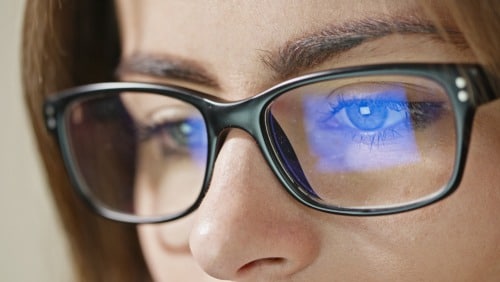How IEP and 504 Plans Relate to Vision
Is your child on an academic support plan? Learn how your child’s learning difficulties can be caused by undetected vision issues.
How IEP and 504 Plans Relate to Vision
As a parent, you know your child like the back of your hand. You know what they need, when they need it, and you can sense when something is off before they even realize it themselves.
When it comes to their academic success and advancement in school, you’re there – every night – helping your son or daughter with homework. If they’ve recently been struggling or you’ve been notified they’re being placed on an IEP or 504 Plan, you may be searching for answers as to why.
Undeniably, your child is bright and wants to learn and achieve.

Did you know that there’s a 75% chance that a child’s poor learning skills or learning difficulties are caused by vision problems?
If you’re trying to navigate your child’s learning issues and have a hunch they could be related to unidentified vision issues, keep reading to learn about IEP’s, 504 Plans, and how your child’s coordination and learning skills heavily rely on his or her ability to see clearly.
What are IEP and 504 Plans?
For students who require more support and/or more individualized instruction, there are special education services – such as IEP and 504 Plans – that can tailor to a student’s exact learning needs. These services strive to ensure that students with learning difficulties who need special accommodations have a level playing field within the classroom.
While these services encompass a lot, the simple difference is that:
Individualized Education Program (IEP) plans are for students who would benefit from more focused, specialized instruction. IEP plan also mandate a special report from a doctor of Optometry or Ophthalmology to be filled out shortly before or during the initial phase of an IEP and then filed with the students IEP official record. Special testing,reporting,and recommendations are required from the eye doctor to help and advance the visual learning of student.
504 Plans are for students who have accessibility needs, such as extended time for tests, large print textbooks, special seating, specific lighting, etc. However, 504 Plans do not deliver specialized instruction, and students on 504 Plans do not qualify for special education programs under the Individuals with Disabilities Education Act (IDEA).
Regardless of which plan your child is placed on, it’s crucial to understand how vision problems can be a main contributor to your child’s challenges in school.
What Research is Telling Us
Researchers at the Ohio State University, with support from the Ohio Optometric Association, have found a conclusive link between vision issues and students who are placed on IEPs or 504 Plans.
- The study focused on 255 students who were on IEPs to establish a connection to vision problems.
- The study focused on students aged 5-18 years old.
- The main takeaway was this: “There is considerable association between ocular anomalies and poor school performance. These problems are illustrated by the high prevalence of a variety of eye problems experienced in patients with IEPs.”
They found that students who were on IEPs had more difficulties with vision issues, such as child eye focus problems, eye tracking problems, and much more, than the general student population.
Do you have school aged children and suspect they contend with eye tracking difficulty, blurry vision or another vision issue that may be interfering with their living and learning needs? Read about signs and symptoms of child eye focus and eye tracking problems and the effects of vision therapy for certain visual skills:
Causes and Symptoms of Eye Focus and Eye Tracking Problems
The Effects of Vision Therapy for Focus and Tracking Problems
When it’s determined that glasses, contacts or surgery can’t treat a certain vision issue, vision therapy can prove effective.
Because vision is the primary sense by which we learn, it’s incredibly common for a child with a learning or behavioral difficulty to also have an underlying, undiagnosed vision problem that’s contributing to their learning/behavioral problems.
Most optometrists use vision therapy as a piece in a multidisciplinary approach in the treatment of varying degrees of eye focus and tracking problems and learning difficulties.
Learn more about pediatric vision therapy, including signs your child may benefit from vision therapy and more:
Pediatric Vision Therapy: Is it Right for My Child?
Vision Therapy Exercises You Can Try at Home
iCare Vision’s Corrective Vision Therapy For Adults and Kids
Furthermore, and perhaps even more alarming, out of the 179 students that required vision treatment from a children’s eye doctor, approximately 69% (124 students) passed the school vision screening exam.
School vision screenings are setting children, parents, and entire academic plans up for failure because they don’t depict the entire picture and fail to identify treatable vision problems that are leading to shortcomings in the classroom.
This is a serious underlying issue in our schools throughout the country.
Why School Vision Screenings Lack in Effectiveness
Vision tests that are administered at your child’s school or pediatrician’s office only catch about 15-20% of vision problems and don’t provide your child’s full vision diagnosis.
These exams only focus on testing a child’s distance vision. But to truly detect vision issues that can lead to eye strain, tiredness, headaches, and learning difficulties, the following must the thoroughly assessed:
- Near vision (critical for reading)
- Binocular coordination
- Eye movement skills
- Focusing skills
- Peripheral awareness
When It’s Time to See a Children’s Eye Doctor
Is your child expressing or displaying any vision-related issues, such as, but not limited to: squinting, frequent eye rubbing, extreme light sensitivity, chronic eye redness or tearing, viewing objects really close-up or moving their head in an odd position to see better?
If your child is on an academic support plan and/or showing or talking about vision issues they’re experiencing, it’s time to get a comprehensive pediatric eye exam by a children’s eye doctor.
Child eye tracking problems, eye focus problems, and other vision issues can be the root cause of your child’s learning issues.
A children’s eye doctor will run specialized tests to identify your child’s exact visual learning problems and recommend effective solutions, such as a prescription and vision therapy exercises.
Each School district has a parent/child advocate that can help you and the school to find the right help and directions. These key people know the in’s and outs of getting local, state, and federal help if your child is not performing.
As the school year gets underway, schedule your child’s pediatric healthy eye exam today. As Dr. Wineland likes to say, “help your child perform up to his or her IQ.”
Questions for Kids: Tell Us About What You See at School
- Did you feel better when you sit in the front of the class or back of the class?
- Is it easy to read words or see pictures from your papers and textbooks?
- Do you feel like you can see clearly? Or do your eyes feel burry?
- Do you feel like you squint to read a book, the chalkboard, or a computer screen?
- Do your eyes hurt after using a computer?
- Do you ever get a headache after reading?
Be sure to tell a parent or teacher what your eyes feel like, or what you’re experiencing.
Understanding what is going on with your eyes is very important to help you see clearly and comfortably – and help you do your best in school.

